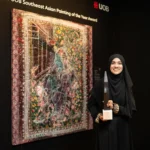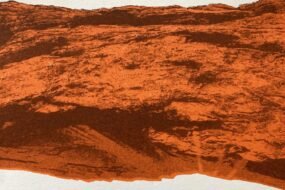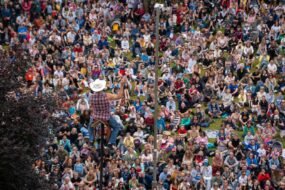
Carla Stellweg, the fearless curator and writer who shifted the very ground of Mexican contemporary art at a critical juncture for the country’s history and identity, died on Monday, October 20. Her passing in her home in Cuernavaca, Mexico, at the age of 83 was confirmed by her son, the writer George Stellweg.
Alongside her contributions to Mexican art scholarship, Stellweg forged a wider path for Latin American and Caribbean artists on a global stage, constellating the women’s rights activism, the marginalization of United States-based Latine communities, class concerns, and institutional hierarchies as interrelated struggles. Among her most lauded achievements is Artes Visuales, the quarterly bilingual contemporary arts journal Stellweg co-founded and edited at the Museo de Arte Moderno (MAM) in Mexico City from 1973 through 1981. Even while operating within the confines of a state-funded publication under the auspices of President Luis Echeverría, whose campaign to usher in a democratic ideal obscured his roles in the nation’s notorious student massacres, Artes Visuales embraced the experimental and the political in “subliminal” ways, Stellweg wrote in a 2010 essay. Issues featured anything from a survey of artists’ thoughts on the Panama Canal to texts on emergent video and conceptual art and early chronicles of Chicano artists.
“This was in the early 1970s, when few paid attention to the art scene involving Mexican Americans,” Stellweg’s friend, the art historian and gallerist Patricia Ruiz-Healy, told Hyperallergic. “This was the first time in Latin America that questions about what Latin American art is were discussed.”
Taiyana Pimentel, director of the Museo de Arte Contemporáneo de Monterrey, emphasized that Artes Visuales made space not just for artists but also for young writers, like philosopher Manuel de Landa, who published one of his first pieces in the journal. “It established a paradigm in Latin American art criticism — an early model that has been followed by other publications on the continent,” Pimentel said.

Stellweg was born in 1942 in Bandung, Indonesia, then the Japanese-occupied Dutch East Indies, where she and her family were imprisoned in a Japanese detention camp through the end of World War II. She studied in the Netherlands in the 1950s and moved to Mexico in 1958, where she absorbed herself in the writings of José Gorostiza, Alfonso Reyes, and other thinkers who propelled a vision of Mexican identity beyond post-revolutionary nationalism. Her career in the arts took off in the mid-1960s, when she started working as an assistant curator for Fernando Gamboa, the renowned museographer and later director of MAM.
Orchestrating Mexico’s presence in shows like Montreal’s Expo 67 and the 1968 Venice Biennale placed Stellweg at the heart of fierce debates around art and modernity. She recounted in a 2021 interview that she faced the ire of muralist titan David Alfaro Siqueiros when he opposed their proposal to show works by Rufino Tamayo and artists of the so-called Generación de la Ruptura, a movement that pushed back against the hegemony of social realism.
Stellweg was later briefly named deputy director of the nascent Museo Tamayo in Mexico City in 1979, and the museum presented an exhibition dedicated to her work in 2023. “She was from everywhere and nowhere,” said Andrea Valencia Aranda, who co-curated the show with Pablo León de la Barra. “This gave her great courage, and allowed her to approach without prejudice artists and movements that did not represent the mainstream.”

Following the abrupt shuttering of Artes Visuales in what she called an act of censorship by MAM under a political changing of the guard, Stellweg relocated to New York City in 1982, where her Soho apartment would become a hub for exchanges around Latin-American art for decades. Aimé Iglesias Lukin, director and chief curator of Visual Arts at Americas Society, which hosted Stellweg in a series of talks around its 2021 exhibition of Latine artists in New York City, remembers Stellweg as a “deeply generous” person who relished in sharing time, space, and ideas with others.
“Most of us came to her through the world of art, but she ended up teaching us about the world of life,” Iglesias Lukin said, recalling Stellweg’s warm and distinct sense of humor. “When I got separated and I felt heartbroken, Carla told me: ‘Oh, this is your first divorce? Welcome! I’ve had three.’”
Stellweg nurtured US-based artists of Latin-American descent, who grappled with the wonders and challenges of a bifurcated existence, and embraced urban and ephemeral art forms like graffiti that broke the mold of mainstream expectations. Like her brief stint at the Museo Tamayo, many of Stellweg’s endeavors during this period were short-lived yet profoundly influential. She cofounded Stellweg-Seguy Gallery in 1983, and in 1986 she became chief curator of the Museum of Contemporary Hispanic Art, a post she held for three years before leaving to establish her namesake gallery on Mercer Street. She dedicated herself to the space for almost a decade, exhibiting the likes of Ana Mendieta, Liliana Porter, Luis Camnitzer, Hannah Wilke, and Vito Acconci. Porter said that she was “immediately captivated” by Stellweg’s spirit. “I had the privilege of witnessing her extraordinary talent and her unwavering commitment to promoting Latin American art, even in settings that were not always welcoming,” Porter added.
From 1997 to 2001, Stellweg led the Contemporary at Blue Star, an alternative art center in San Antonio, Texas. Later, she returned to New York to teach at the School of Visual Arts before making her way back to Mexico, where she would spend the final years of her life.

Unlike high-profile museum leaders who strategically deflect from the political, Stellweg waded eagerly into controversy. She was part of the Contrabienal, a late-1960s effort by Latin American artists to boycott the São Paulo Biennial in protest of Brazilian state repression and the broader terror of military regimes in the region. She leaves behind a trove of writings, newly compiled in a collection edited by Edgar Alejandro Hernández that chronicles her outspoken and incisive reflections on everything from the rise of counter-feminist groups in Mexico to the stifling barriers of the art market.
“Curatorial projects must have major ‘protagonists,’ and big-time moguls flip their trophy works, increasing prices and their earnings from art investments at a stroke,” she wrote in one 2015 essay. “Who is writing art history today? Does the entire sphere reside solely in the hands of private and corporate collectors? Do curator-driven projects play further into this purely monetary system of value? Is there a distinction between private and institutional collecting? Are there still alternatives?”
The curator’s impact on art and its people is captured in an outpouring of tributes and remembrances over recent days. The Venezuelan-American artist Rolando Peña, who was introduced to Stellweg in New York as part of progressive artist groups opposing the war in Vietnam, told Hyperallergic it was “like meeting an angel.” Frederik Schampers, a nephew of Stellweg and director at Gladstone gallery in New York, said she was a “guiding light … an incredibly powerful woman — deeply intelligent, fiercely independent, and profoundly committed to the artists and ideas she believed in.” The New York dealer Henrique Faria called her a “visionary.”
“Carla was a pioneer. Her curiosity for the new and her conceptual rigor made her one of the most critical voices of her generation,” said Patrick Charpenel, director of El Museo del Barrio in East Harlem. “Her departure leaves an irreplaceable void.”
Stellweg’s archives are housed at the Museum of Modern Art in New York and Stanford University. An exhibition dedicated to the legacy of Artes Visuales, curated by scholar Harper Montgomery in collaboration with the Institute for Studes on Latin American Art, is on view at Hunter College’s Bertha and Karl Leubsdorf Gallery in Manhattan through December 13.











